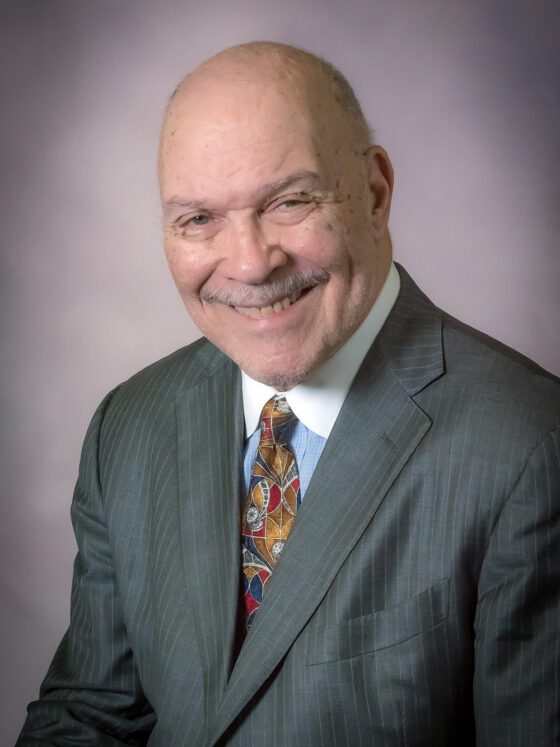Daniel P. Henson
PRINCIPAL & PRESIDENT

Daniel P. Henson, III has over thirty years of responsible positions in the management of large organizations. He has particularly specialized in successfully managing through difficult, complex situations. He understands well the principles of correcting troubled private and public sector organizations. From 1993 until 1999, he was the Executive Director of one of the Nation’s largest public housing authorities, as well as the Commissioner of Baltimore’s Department of Housing and Community Development. As such, he managed these agencies to one of the most spectacular turnarounds in recent housing agency history.
After working his way through Morgan State University at General Motors Parts Division in Baltimore (including being elected union shop steward), Dan Henson taught junior high school social studies before joining Metropolitan Life Insurance Company as a sales agent. He became a manager a few years later. He won virtually every honor in sales and sales management in the life insurance industry. In 1974 he became the Maryland general agent for the Guardian Life Insurance Company of New York. In 1977 he was appointed Regional Administrator of the U.S. Small Business Administration with offices in Philadelphia. A few years later, President Carter named Henson Director of the U.S. Minority Business Development Agency. In each of the instances of running federal offices, Henson was asked to turn around deeply troubled organizations and did so successfully.
Returning home to Baltimore in 1981, he worked with the City’s premier business group, The Greater Baltimore Committee in developing programs to assist minority owned businesses including the Development Credit Fund, a $7.5 Million non-profit re-lender of funds provided by the local banks. He also worked as a vice president for G&M Oil Company and hosted a weekly television show in the mid 1980’s.
Henson joined Struever Bros. Eccles and Rouse as Vice President in 1984. He helped the company grow to become a major real estate developer and contractor in the Baltimore area and became a partner in 1990. He specialized in for sale housing and the adaptive reuse of historic structures for low and moderate-income rental housing. There are many buildings and communities in the Baltimore area with the “Henson touch” of high-level design and functional, built-in management plans for the long-term viability of the property. In addition to the for-profit activities, he also developed a plan to adapt the 100-year-old Orchard Street Church as the magnificent headquarters for the Baltimore Urban League and led the development team for the headquarters building of the Legal Aid Bureau in Baltimore’s Government Center. He also gained a thorough understanding of complex real estate financial transactions.
In 1993, Mayor Kurt Schmoke asked Dan to join his administration in the dual roles of Commissioner of Housing and Community Development and Executive Director of the Housing Authority of Baltimore City (HABC). HABC is the Nation’s fifth largest housing authority. In 1993 it had over 18,000 units of conventional public housing units and 5,000 Section 8 Certificates. Commissioner Henson laid out a plan for taking this near troubled agency (HABC scored in the low to mid-60’s on the PHMAP) and turning it around into a high performer. He laid out three core principles: rethink all of our housing stock; develop and implement a good neighbor policy for customers; and respect and retrain all of our colleagues. When he returned to the private sector in 1999, HABC ranked in the 80’s and was on the road to scoring 100% on the new PHAS.
Beginning in 1993, under Henson’s leadership, HABC developed a national reputation as an aggressive competitor for resources to improve its housing stock consistent with the City’s overall redevelopment plan. As a product of public housing having grown up in Baltimore’s Poe homes, Henson appreciated the opportunity, to provide more functional and practical housing for lower income families. Henson formed a close alliance with the various resident groups in all of HABC’s forty public housing communities, but particularly in the four dense family high rise developments. In partnership with the residents, he developed a plan to demolish all four developments and to build mixed income communities on their sites and to replace the remainder of the units in lower density, low poverty communities. That plan originally required $293 Million. He partnered with the State of Maryland to contribute $65 Million and the City of Baltimore to put in $35 Million. The remainder was garnered in a series of high scoring responses to competitive HUD Notices of Funding Availability for the HOPE VI program. HABC was awarded a HOPE VI revitalization grant for the six consecutive years that Henson headed the agency.
The public housing re-developments now had over $600 Million committed, with $176 Million from HUD’s HOPE VI program, the most of any city in the Nation. Additionally, Henson developed a comprehensive plan for the physical redevelopment of all HABC housing stock over the next ten years. Many of these developments utilize mixed finance plans including the Low Income Housing Tax Credit, the Historic Tax Credit and Tax Exempt Bonds.
In addition to the broad range of leadership roles he played as Commissioner, Henson has served as a board member of the Homebuilders Association of Maryland and the Council of Large Public Housing Authorities (CLPHA). He is currently Chairman of the Board of the National Organization of African Americans in Housing (NOAAH). He is also a member of the faculty of the University of Maryland at College Park School of Public Policy’s Housing Reform curriculum. Henson is the recipient of numerous national and local awards for his work in housing and community and economic development.

Daniel P. Henson, III has over thirty years of responsible positions in the management of large organizations. He has particularly specialized in successfully managing through difficult, complex situations. He understands well the principles of correcting troubled private and public sector organizations. From 1993 until 1999, he was the Executive Director of one of the Nation’s largest public housing authorities, as well as the Commissioner of Baltimore’s Department of Housing and Community Development. As such, he managed these agencies to one of the most spectacular turnarounds in recent housing agency history.
After working his way through Morgan State University at General Motors Parts Division in Baltimore (including being elected union shop steward), Dan Henson taught junior high school social studies before joining Metropolitan Life Insurance Company as a sales agent. He became a manager a few years later. He won virtually every honor in sales and sales management in the life insurance industry. In 1974 he became the Maryland general agent for the Guardian Life Insurance Company of New York. In 1977 he was appointed Regional Administrator of the U.S. Small Business Administration with offices in Philadelphia. A few years later, President Carter named Henson Director of the U.S. Minority Business Development Agency. In each of the instances of running federal offices, Henson was asked to turn around deeply troubled organizations and did so successfully.
Returning home to Baltimore in 1981, he worked with the City’s premier business group, The Greater Baltimore Committee in developing programs to assist minority owned businesses including the Development Credit Fund, a $7.5 Million non-profit re-lender of funds provided by the local banks. He also worked as a vice president for G&M Oil Company and hosted a weekly television show in the mid 1980’s.
Henson joined Struever Bros. Eccles and Rouse as Vice President in 1984. He helped the company grow to become a major real estate developer and contractor in the Baltimore area and became a partner in 1990. He specialized in for sale housing and the adaptive reuse of historic structures for low and moderate-income rental housing. There are many buildings and communities in the Baltimore area with the “Henson touch” of high-level design and functional, built-in management plans for the long-term viability of the property. In addition to the for-profit activities, he also developed a plan to adapt the 100-year-old Orchard Street Church as the magnificent headquarters for the Baltimore Urban League and led the development team for the headquarters building of the Legal Aid Bureau in Baltimore’s Government Center. He also gained a thorough understanding of complex real estate financial transactions.
In 1993, Mayor Kurt Schmoke asked Dan to join his administration in the dual roles of Commissioner of Housing and Community Development and Executive Director of the Housing Authority of Baltimore City (HABC). HABC is the Nation’s fifth largest housing authority. In 1993 it had over 18,000 units of conventional public housing units and 5,000 Section 8 Certificates. Commissioner Henson laid out a plan for taking this near troubled agency (HABC scored in the low to mid-60’s on the PHMAP) and turning it around into a high performer. He laid out three core principles: rethink all of our housing stock; develop and implement a good neighbor policy for customers; and respect and retrain all of our colleagues. When he returned to the private sector in 1999, HABC ranked in the 80’s and was on the road to scoring 100% on the new PHAS.
Beginning in 1993, under Henson’s leadership, HABC developed a national reputation as an aggressive competitor for resources to improve its housing stock consistent with the City’s overall redevelopment plan. As a product of public housing having grown up in Baltimore’s Poe homes, Henson appreciated the opportunity, to provide more functional and practical housing for lower income families. Henson formed a close alliance with the various resident groups in all of HABC’s forty public housing communities, but particularly in the four dense family high rise developments. In partnership with the residents, he developed a plan to demolish all four developments and to build mixed income communities on their sites and to replace the remainder of the units in lower density, low poverty communities. That plan originally required $293 Million. He partnered with the State of Maryland to contribute $65 Million and the City of Baltimore to put in $35 Million. The remainder was garnered in a series of high scoring responses to competitive HUD Notices of Funding Availability for the HOPE VI program. HABC was awarded a HOPE VI revitalization grant for the six consecutive years that Henson headed the agency.
The public housing re-developments now had over $600 Million committed, with $176 Million from HUD’s HOPE VI program, the most of any city in the Nation. Additionally, Henson developed a comprehensive plan for the physical redevelopment of all HABC housing stock over the next ten years. Many of these developments utilize mixed finance plans including the Low Income Housing Tax Credit, the Historic Tax Credit and Tax Exempt Bonds.
In addition to the broad range of leadership roles he played as Commissioner, Henson has served as a board member of the Homebuilders Association of Maryland and the Council of Large Public Housing Authorities (CLPHA). He is currently Chairman of the Board of the National Organization of African Americans in Housing (NOAAH). He is also a member of the faculty of the University of Maryland at College Park School of Public Policy’s Housing Reform curriculum. Henson is the recipient of numerous national and local awards for his work in housing and community and economic development.



